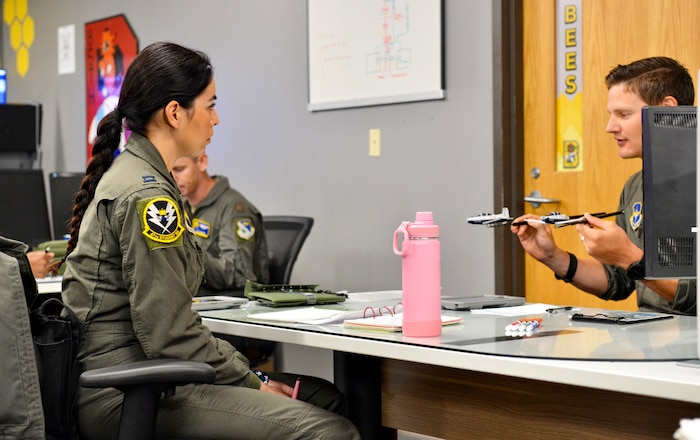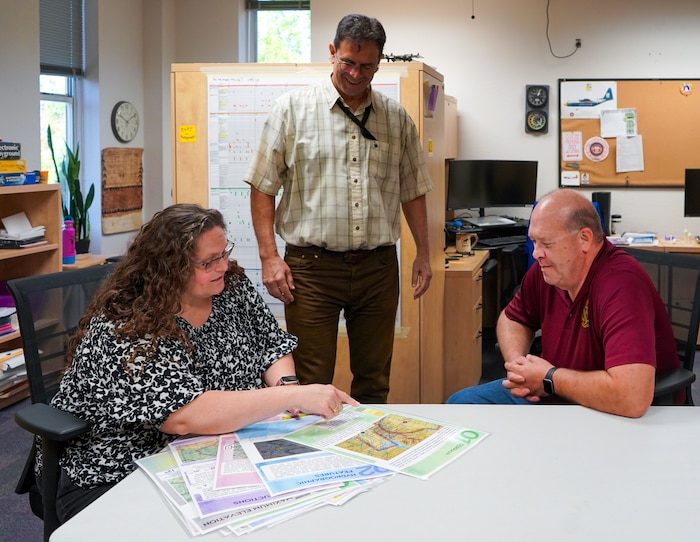A modernized aviation specific program, designed to enhance the student experience, recently launched at the Defense Language Institute English Language Center.
This is the catalyst for continued improvement and modernization of the Specialized English Training aviation curricula.
DLIELC performs a unique mission teaching English to international partners, U.S. service members and civilian personnel. Beyond teaching the basics of English as a second language, DLIELC also offers English for specific purposes such as instruction for a student's career path, which prepares them to attend follow-on training. A number of these training locations nest under 19th Air Force's pilot training mission.
Students not only learn English, but they also establish a foundation of security cooperation and building partnerships.
"Everything we do builds a foundation for security cooperation and that starts with the foundation of language," said Maj. Erin Doyle, international military student officer and T-1 instructor pilot with the 47th Flying Training Wing at Laughlin Air Force Base, Texas.
Doyle and Maj. James Stevens, 332nd Training Squadron director of operations, are the workgroup liaisons within their respective units who are leading collaborative efforts to ensure student pilots receive a comprehensive educational experience from the moment they attend DLIELC until they arrive at their follow-on training.
"The goal is continuous improvement of the syllabus, producing the best pilot we can," Doyle said.
The new aviation modernization curriculum is a tailored educational program offered alongside classroom instruction and simulated training to pilot candidates, aircrew, and those within the aviation field using educational resources and practical exercises.
"The DLIELC aviation modernization curriculum is an exclusive English language program with a special emphasis on military aviation," said Humberto Garcia, DLIELC 332nd TRS interim chief of curriculum development.
Before students begin the program, they must first pass the English Comprehension Level and/or Oral Proficiency Interview to assess their understanding.
They then progress to Specialized English training. This includes training at the DLIELC Aviation Language Training Center. Students receive hands-on experience in a simulator, as well as walk through the process of flying from flight planning to debriefings - all with the purpose of being immersed in the English language.
"The incorporation of the DALTC into the curriculum for aviation modernization is done in a formal manner, and it is accompanied by performance evaluations. Additionally, learners are provided with a glossary of aviation terminology," Garcia said.
As part of the modernized curriculum, students experience three simulator sessions.
"The first session will be a normal flight and the second session will be around the airfield. The third week will be an emergency or non-standard situation that will be off-script," Stevens said, adding that demonstrating the off-script scenarios tests their reaction times in the English language.
"What do you say? How do you act when you go off-script?" Stevens said. These scenarios will help students and instructors determine if, "they can process and understand the situation, or did they just memorize the script?"
The DALTC offers a valuable learning experience with hands-on training, allowing students to practice their communication skills.
"We are introducing them to the speed aspect of their communication," Stevens said.
He added that the training lab gives students real-time experience to adjust the speed at which each individual needs to think and speak. This allows them to demonstrate real-time reactions during classroom activities and flight simulator lessons.
"Our mission is to assist and cultivate the English language proficiency of international aviation students who are enrolled in American military flying training," Garcia stated.
The updated curriculum prioritizes military aviation language development and facilitates customized instruction, emphasizing specific language skills and terminology crucial for students entering professional military training.
The 19th Air Force and DLIELC collaboration enables the working group to address English language challenges on campus and extend this effort to follow-on training. Site visits and curriculum reviews allow the 19th Air Force and DLIELC curriculum development teams to provide more in-depth information and training on the inner workings of language acquisition.
"Building strong ties between 19th Air Force, DLIELC and all the UPT (Undergraduate Pilot Training) bases in collaboration are how we build the strong foundational skills in order to establish strong security cooperation across the enterprise," Doyle added. "We can't amend our curricula in isolation. Creating this collaboration allows us to advance our capabilities together. I think that's the most important thing for all of us and what everyone cares about, which is why everyone is really invested in doing this right."
DLIELC promotes security collaboration and partnerships by offering in-residence English language instruction and cultural immersion to more than 100 countries, as well as in over 30 nonresident locations around the world.








